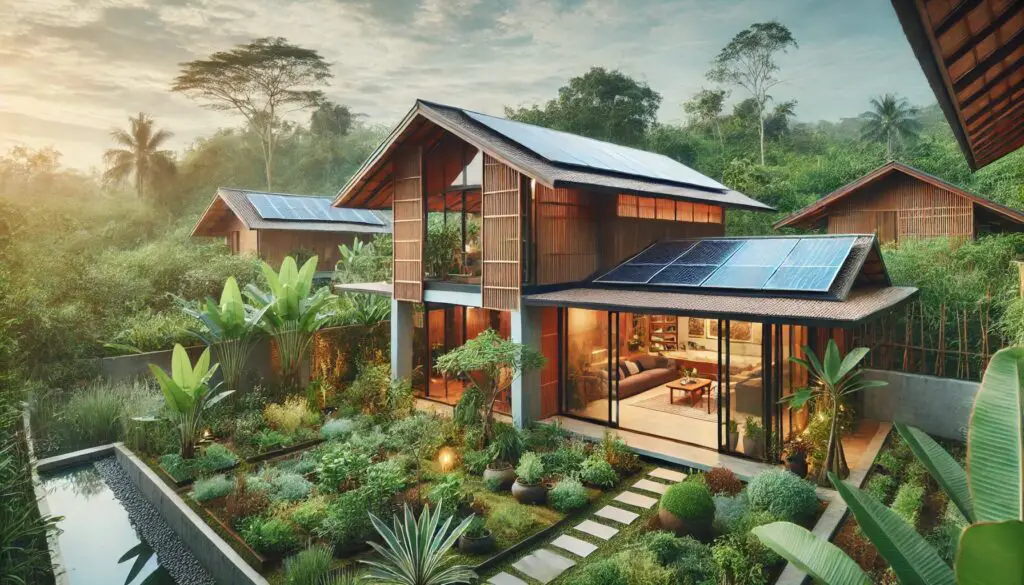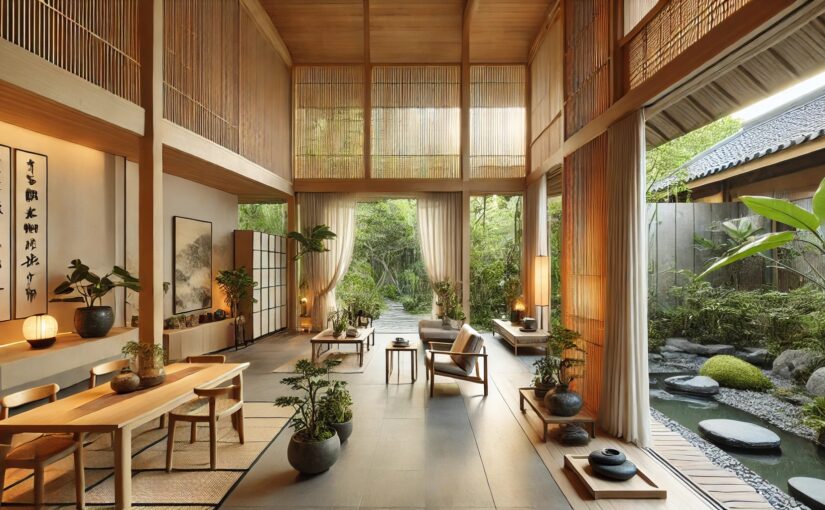In recent years, the concept of sustainable living has transitioned from a trendy buzzword to a necessity. As we become more aware of the environmental impacts of our daily choices, it’s no wonder that Asia houses, one of the most significant aspects of our lives, is undergoing a green revolution. Surprisingly, Asia has emerged as a leader in this sustainable housing movement. And let me tell you, the innovations are not just about planting a few trees in the backyard or installing a couple of solar panels on the roof. We’re talking about a complete reimagining of what a home can be—both for the environment and for the people living in it.
But what makes Asia houses so special? Why are they leading the charge in sustainable living? And, perhaps more importantly, why should you care?
A Fusion of Tradition and Innovation
First off, let’s talk about the architectural philosophy that underpins much of Asia’s housing. In many Asian cultures, the concept of harmony with nature isn’t just an idea—it’s a way of life. Traditional Japanese homes, for example, are designed to blur the lines between indoor and outdoor spaces. Sliding doors open onto gardens, and natural materials like wood and bamboo are used extensively. The result? Homes that feel like a part of the natural landscape rather than a blot on it.
But Asia’s sustainable housing isn’t stuck in the past. Modern innovations have been seamlessly integrated into these traditional designs. In countries like Japan and South Korea, houses are now being constructed with cutting-edge materials that offer excellent insulation and durability while being environmentally friendly. These materials often include recycled products, which help reduce waste, or locally sourced components that minimize carbon footprints.
The Rise of Eco-Friendly Communities
Sustainable living isn’t just about individual homes—it’s about entire communities working together to reduce their environmental impact. Asia has some of the most forward-thinking eco-friendly communities in the world.
Take, for example, the Fujisawa Sustainable Smart Town in Japan. This isn’t just a neighborhood; it’s a living, breathing experiment in sustainable living. Homes in this community are equipped with energy-efficient appliances, solar panels, and advanced monitoring systems that allow residents to track their energy usage in real time. The town also boasts electric vehicle charging stations, community gardens, and even shared transportation options to reduce the need for personal cars. Imagine living in a place where your carbon footprint is as light as a cherry blossom gently falling to the ground. That’s the Fujisawa dream.
In Singapore, another example of forward-thinking design, the Punggol Digital District is being developed with sustainability at its core. The district will feature smart energy grids, extensive greenery, and a commitment to reducing waste. Homes here will be designed to maximize natural light and ventilation, reducing the need for artificial lighting and air conditioning. It’s like Mother Nature herself had a hand in drawing up the blueprints.

Water Conservation: The Lifeblood of Asia’s Green Homes
Asia is home to some of the most populous countries in the world, which means that water conservation is a top priority. In many Asian houses for sale, you’ll find features designed specifically to reduce water usage.
Take the rainwater harvesting systems commonly found in homes across India. These systems collect rainwater, which is then filtered and used for non-potable purposes such as flushing toilets and watering gardens. It’s like nature’s way of giving you a high five for being environmentally conscious. And speaking of gardens, many Asian homes are designed with rooftop or vertical gardens that help reduce runoff and lower temperatures around the home.
In Southeast Asia, where monsoons are a part of life, homes are often built with permeable surfaces and strategic landscaping that help manage water flow and prevent flooding. It’s not just about saving water—it’s about working with the natural water cycle, rather than against it.
Energy Efficiency: Turning Up the (Solar-Powered) Heat
When it comes to energy efficiency, Asia is truly shining—literally. Solar power has become a cornerstone of sustainable living in the region. In countries like China, which is already a global leader in solar energy production, it’s not uncommon to find homes with rooftop solar panels. These panels not only provide energy for the home but also contribute to the grid, ensuring that even more households can benefit from clean energy.
But it doesn’t stop there. In South Korea, the government has been incentivizing the construction of energy-efficient homes through various programs. One such initiative is the “Zero Energy Home” project, which aims to reduce energy consumption by integrating solar power, high-efficiency heating and cooling systems, and advanced insulation materials. The result? Homes that not only keep your utility bills low but also make you feel like you’re living in the future—minus the flying cars, of course.
Bamboo: Asia’s Green Gold
Let’s talk materials—because what’s a sustainable home without sustainable materials? Bamboo often referred to as “green gold,” is one of the most versatile and sustainable building materials on the planet, and Asia is the epicenter of its use.
Bamboo grows incredibly fast, up to a meter a day in some cases, and it doesn’t require replanting after harvest. This makes it an ideal resource for sustainable construction. In countries like Vietnam and Indonesia, bamboo is being used not just for floors and walls, but also for entire structures. Some modern homes are even being designed entirely out of bamboo, offering a striking blend of strength, flexibility, and sustainability. Plus, it gives your home that earthy, zen-like vibe that pairs perfectly with a cup of green tea.
The Cultural Connection to Sustainability
One of the most fascinating aspects of Asia’s leadership in sustainable living is how deeply it’s connected to cultural values. In many Asian societies, there’s a strong emphasis on community and collective responsibility. This cultural mindset naturally extends to the way you build and live in your homes.
For example, in traditional Chinese architecture, the concept of “feng shui” emphasizes harmony between individuals and their environment. This ancient practice often guides the design of homes. It ensures they are in sync with the natural world, which aligns perfectly with modern sustainability principles. It’s like the ancient Chinese were practicing eco-friendliness long before it became cool.
In rural areas of countries like Bhutan and Nepal, houses often use traditional building methods that utilize local materials, such as stone, mud, and wood. These homes are not only sustainable. Rather, reflect the cultural heritage and identity of the people who live in them. It’s like living in a history lesson, but one that’s comfortable and cozy.
Asia Houses for Sale: Your Key to Sustainable Living
So, you’ve been searching for “Asia houses for sale,” and now you’re wondering, “Is it worth it?” The answer is a resounding yes! Asia offers some of the most innovative, eco-friendly housing options in the world. Whether you’re looking for a high-tech smart home in Japan, a bamboo haven in Bali, or a water-efficient retreat in India, you’ll find that Asia has something for every eco-conscious buyer.
But it’s not just about buying a house—it’s about investing in a lifestyle. By choosing a sustainable home, you’re not just reducing your environmental impact; you’re also becoming part of a global movement towards a greener, more responsible way of living. Plus, you’ll have the perfect excuse to brag to your friends about your house that basically hugs the earth.
The Future is Green—and It’s in Asia
As we look to the future, it’s clear that Asia will continue to play a leading role in sustainable living. With a rich blend of traditional wisdom and cutting-edge innovation, the region is setting the standard for what eco-friendly housing can and should be. Whether you’re an environmentalist, an architecture enthusiast, or just someone who enjoys a good cup of tea in a bamboo-clad living room, Asia’s sustainable homes offer something for everyone.
So, the next time you’re on the hunt for a new place to live, do not just look for the cheapest houses in the world, consider looking East. When it comes to sustainability, Asia houses are more than just homes—they’re a blueprint for the future.
